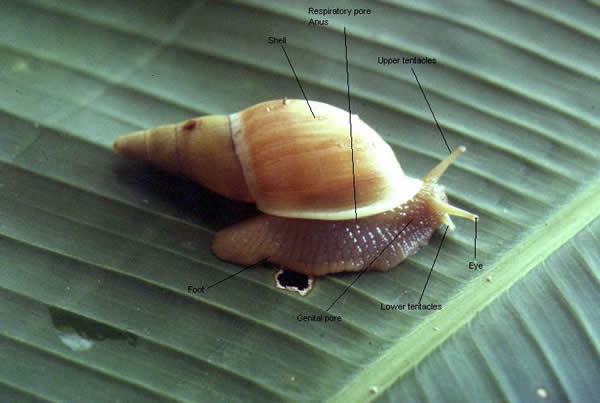
Fig 2-7a Snail diagram
THE WORLD OF LAND SNAILS
Welcome to the little known world of land snails. Although the mollusks have more species than any animal group except insects, we know very little about their natural history. The land snail species studied have been agricultural pests, disease carriers, and the edible.
Currently the spectacular Ranomafana land snails are its forgotten fauna. This guide will enable these remarkable snails to be included in the ecotourists’ Ranomafana experience.
The California Academy of Sciences’ 1997 and 1998 expeditions to Ranomafana National Park were to inventory its flora and invertebrate fauna. I accompanied the 1998 expedition to document the terrestrial land snail fauna and to prepare a land snail guide.
An introduction to the natural history of land snails can be achieved by answering some of your land snail questions.
1 Q – Why look at snails? Of all the creatures in the animal kingdom why single out the snail? What makes them special?
A – The snail is an abundant animal and moves slow enough to be easilycaught and observed. A land snail specimen has many facets - historical, zoological, zoographical, and ecologic. Who first discovered the species? Why, where, and when? Who first described it? How did the scientist receive the specimen and when? Where does the animal live? What does it eat? What is its protection from desiccation? How does it relate to its neighbors and environment? Who are its relatives and how are they related? Who are its enemies and how does it repel them?
3 Q - What good are snails?
A - In nature everyone has a job. There is no unemployment. All life belongs in two big occupations - producers and consumers. The producers are the plants which use sunlight to create living tissue. The consumers eat the producers. There are two basic kinds of consumers. These are herbivores (vegetarians) and carnivores. The most important of the consumers is the subgroup called reducers who eats dead vegetation and animal products because without the reducers the earth would be buried in dead bodies and excrement. This is where most of the snails fit.
5 Q - Are snails successful animals?
A - If success is measured by how long you've survived, snails are very successful. They've been around 500 million years. If successful is how well you've adopted to the environment, snails have adapted to all climates and altitudes. It has emerged from the water and now lives a diversified life in a new environment and is found from the tropics to the tundra and from sea level to mountain heights.
7 Q – What makes a snail a snail?
A - In its simplest form a snail can be thought of as consisting of a body mass (visceral hump) covered with protective armor (shell) from which extend sensory-feeding and locomotive areas (head and foot).

Fig 2-7a Snail diagram
8 Q – What is the life sycle of a snail?
A – The driving force in the life cycle (youth, adult, old age) of a snail is reproduction. The stages are determined by their reproductive potential. Youth has no reproductive capacity, adult has the maximum capacity, and old age has a low capacity. In old age when the capacity declines the individual is not reproductively useful and dies.
9 Q - What is the visceral hump?
A - The visceral hump is an area elevated above the foot and usually completely and permanently covered by the protective shell. It is the center of body metabolism and contains the vast bulk of digestive, reproductive, circulatory, and excretory organs.
11 Q - What is the mantle?
A – Snails have two unique structures, the mantle and the radula. The mantle is a flap from the visceral hump which extends out and downward between its outermost edge and the visceral hump forming a cavity. This cavity is called the mantle cavity. The mantle secretes the snail shell, increasing it in size by adding to its edge and strengthening it by adding additional inner layers.
13 Q - What is the mantle cavity?
A - The mantle cavity is the key to snail success and the limit to snail potential. The external opening of the digestive, excretory, and reproductive systems usually enter into this cavity. It also normally accommodates the breathing surfaces, in the form of 'gills' for the operculates or a 'lung' surface for the pulmonates.
15 Q - What is the radula?
A - The other uniquely snail organ is the radula. This is essentially a 'toothed tongue.' There are from a few to a quarter of a million teeth mounted on this flexible membrane. This structure is partly extruded from the mouth and licked or scraped across the surface on which the snail is feeding. Worn or dull teeth are discarded at the anterior end of the radula. New replacement teeth are formed at the posterior end. The tooth bearing membrane gradually grows forward, moving new teeth into the feeding position and worn teeth to the area where the membrane can be reabsorbed by the animal. The teeth fall off and may be swallowed with the mollusk's food. Naturally surrounding and operating the radula are a complex mass of muscles.
17 Q - Do you want to feel the radula?
A - Place a large snail or slug in the palm of your hand and wait for it to become active. You will be able to feel the radula scrape across your skin.
19 Q - Where is the snail's head?
A – Snails are like American football players, they have no necks! The head is smoothly attached to the front end of the foot and has either one or two pairs of retractable tentacles.
20 Q – What is the function of the retractable tentacles?
A – Operculates have one set of tentacles with the eye located at the base of the tentacle. The tentacle is presumed to be the seat of the sense of smell. Pulmonates have two sets of tentacles. The longer set houses the eyes at their tip. The shorter set is, like the operculate, presumed to be the seat of the sense of smell.
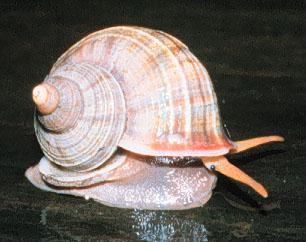
Fig 2-20a Tropidophora showing eye at base of single set of tentacles.
21 Q - What is on the head?
A - The head houses the tentacles, eyes, and various chemical receptors (chemoreceptors) as well as the mouth opening with its radula and associated muscles.
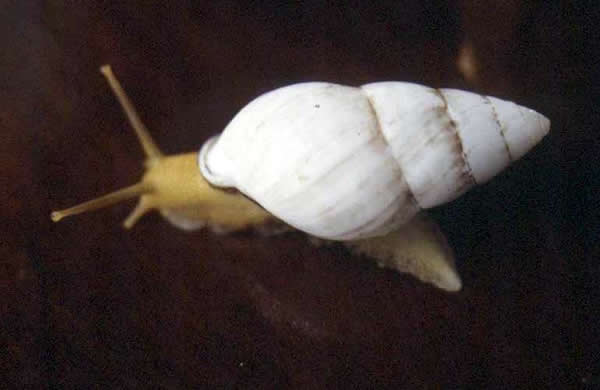
Fig 2-20bTwo sets of tentacles on Amphidromus with the eyes at tip of upper
pair.
FOOT
23 Q - What is the foot and what does it do?
A - The snail foot is used for locomotion and is essentially a broad, flat organ which uses ciliary waves and/or muscular contractions for clinging or gliding.
24 Q – Is the foot of all snails the same color?
A – The foot like the shell can have many color patterns.
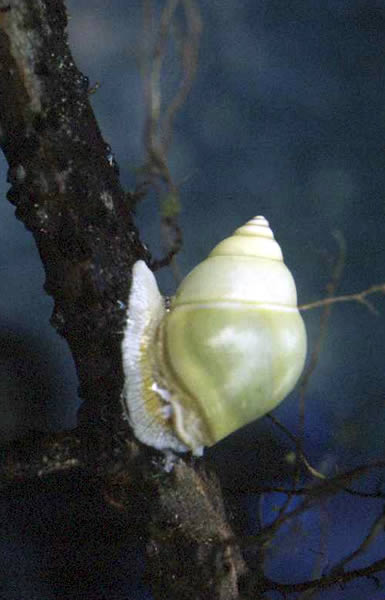
Fig 2-24a Foot pattern.
25 Q - How are land snails classified?
A - The classification of land snails is based on the reproductive organs, internal anatomy, and lastly the shell form.
27 Q - How does the scientist determine if a specimen is a new species?
A – This question was answered (by someone else), "I know it's a new species because I know all the species it isn't."
28 Q – How are snails named?
A – The purpose of giving anything a name is to be able to refer to it. Because each locality has a different name for the same creature, scientists give binomial names to animals and plants. A binomial name is similar to a given name and a family name except they are written with the family name first (like you do in Madagascar) with no punctuation between. The family name (genus) always starts with a capital letter. The given name (species) is lower case. Examples are: family given common genus species common
------ ----- ------ ----- ------- ------
Smith John Bud Achatina fulica African snail
The person who first scientifically describes an animal can name it almost anything he wants. There are rules to keep thing running smoothly. One of these is that the name first used has priority. The name of the scientist and the date of publication follow the species. The full scientific name of the Giant African land snail is Achatina fulica (Bowdich, 1822). The parenthesis around the author name and date indicate that the genus has been changed since the species was originally named. “Common names change from place to place, scientific names from time to time.”
29 Q - What is the shell?
A - The shell is an armored shield for the tasty morsel within it. It is formed by the mantle and is extremely variable in both form and ornamentation.
31 Q - Can all snails fit into their shells?
A – In operculate snails the animal must fit within the shell or else the operculum can’t close. The majority of pulmonate snail shells have plenty of room for the entire body to be withdrawn into it. The trend in pulmonate snails is for the shell size to be reduced relative to the soft parts. Snails which are on the road to slugdom often are too large to be contained in the reduced shell. In most major families there are some species where the shell has been reduced so the soft parts can no longer be withdrawn or the animal has evolved so the shell is absent or reduced to a remnant. In these cases the animal has evolved other basic defense mechanisms and predation is unlikely. Another possibility is that the energy cost of building a shell is greater than the value of the shell.
33 Q - What land snail has the largest shell?
A - Achatina achatina of Eastern Africa is the world's largest land snail. In June 1976 in Sierra Leone a shell was found with a length of 27.3 cm
(10 3/4") and weighed 900 grams (1.98 pounds or 31.75 ounces).

Fig 2-33a Achatina achatina largest land snail species with a European garden
snail for scale.
The largest snail in Madagascar is the introduced Achatina immaculata at 150 mm (6”).
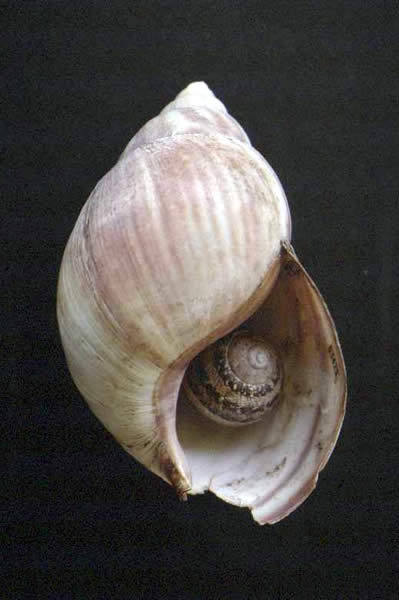
Fig 2-33b Achatina immaculata with a European garden snail for scale.
The largest native snail at Ranomafana is Helicophanta farafanga with a shell length of 92 mm (3.6”) and a width of 70 mm (2¾”).
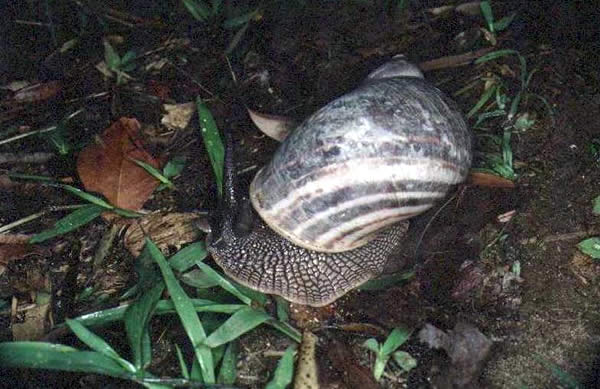
Fig 2-33c Helicophanta farafanga.
35 Q - Why are some shells of the same species thick and some thin?
A - The availability of calcium in their diet determines if the shell is thick or thin. Many years ago in the 1930s juvenile shells of Arianta arbustorum, a common European land snail were raised under two diet conditions - calcium rich and calcium deficient. It was observed that both lots grew to the same size but those grown on the calcium rich diet had shells almost four times heavier than those grown on a calcium deficient diet. I have observed this diet restriction in Achatina fulica living on volcanic (calcium deficient) and coral (calcium rich) islands of the Pacific.
37 Q – Why do some snails live in a shell consisting of many whorls and others in a shell of few whorl??
A - It is difficult to explain. Maybe it’s a project you should work on. For example, the large Helicophanta farafanga has 4 whorls and slender Subulina octona has 9.
39 Q - Why are there so many shell shapes?
A – A 1980 study showed that high-spired shells with multiple whorls prefer to crawl on vertical surfaces. Those with depressed shells and usually with fewer whorls generally prefer horizontal surfaces. Why are the ground burrowers usually high spired? Maybe because it is easier to burrow if you are pointed. This is an observation and does not explain why.
41 Q - How can you determine if the shell is an adult?
A - The teeth and reflecting of the lip usually occur when the animal is sexually mature or full grown. This assumes that the adult species has teeth and/or a reflected lip.
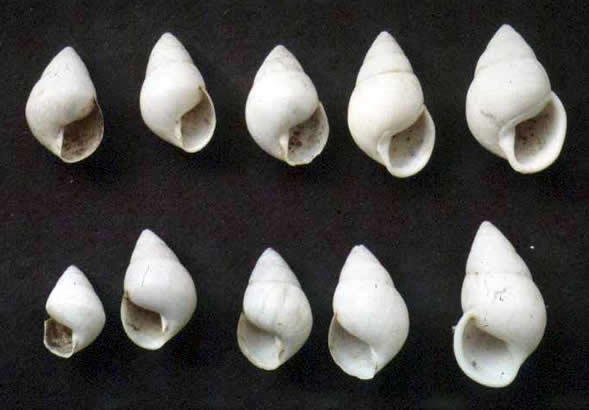
Fig 2-41a Dextral & sinistral growth series.
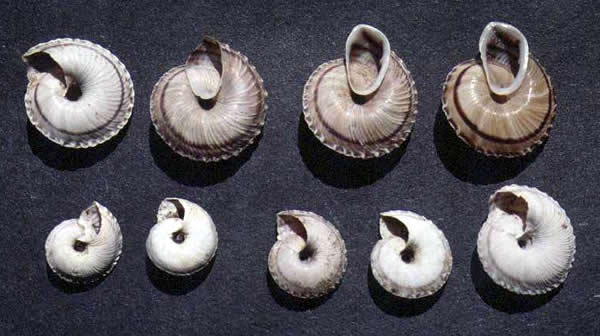
Fig 2-41b Obba rota growth series.
If the edge of the mouth is soft and flexible while the shell is otherwise quite firm, the animal is pretty certainly a juvenile. Another way to determine a juvenile is by measuring the shell size and counting the number of whorls. Compare these with adult shells of related species. See if your specimen is in the right proportion (number of whorls for the diameter) to be a juvenile.
43 Q - How are shell color patterns formed?
A - The shell itself is being continuously deposited throughout its life. The deposition of pigment which produces its color pattern is therefore a biochemical record of the individual snail from cradle to grave. The shell pattern is a graphic record of the secretion activity along a line of cells on the mantle edge. The ground-color is produced by the whole cell line and banding by special groups of cells. Where the activity of these groups of cells is cyclical, blotching results. Where the activity focus moves up and down along the mantle edge, or where activity spreads from a focus, zigzag or hollow V-shaped patterns result.
45 Q - Is there a correlation between color and habitat?
A – In general, tree dwelling snails are bright colored and tend to become elevated or conical, while ground snails are duller or brown, and usually depressed.
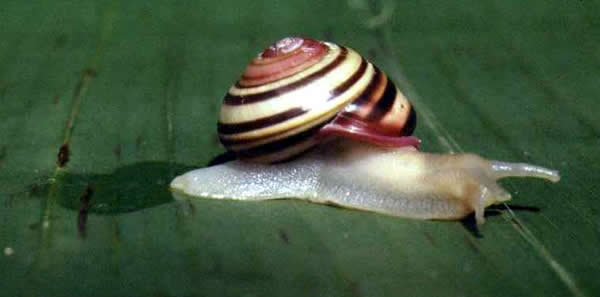
Fig 2-45a Bright color pattern of tree snail.
46 Q - Why does the same species have variations in the color pattern?
A - Birds are a principle predator of land snails. They use "pattern recognition" to identify prey species. If 70% of the snail shells have three spiral bands and the remainder have two or four, the birds will prey on the 70% and the remaining 30% will be safe. Variation in the shell pattern is an effective means to insure species survival from a "pattern recognition" prey.
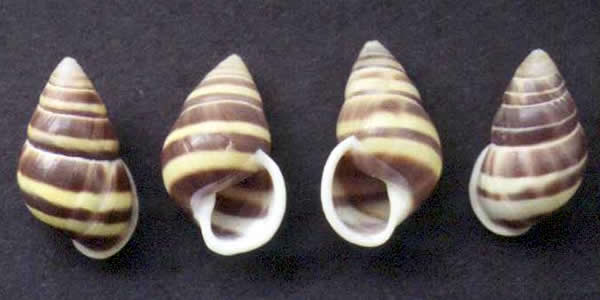
Fig 2-46a Color pattern recognition.
47 Q – Do snails repair damage to their shells?
A – Snails do actually restore broken parts and heal over breaks in their shells.
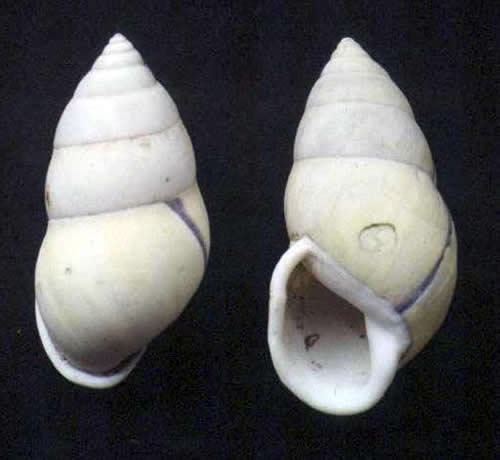
Fig 2-47a The shell was punctured and repaired.
48 Q – How is the repair made?
A – These two grades of restoration correspond to the two diverse shell making regions of the mantle. The young marginal part of the mantle is able to make all the outer layers with its colors and architecture. The older parts of the mantle far from the mantle margin can only add innermost layers to the shell or function after breaks to supply a sort of cement to mend the break but not to actually restore it to look likenew.
49 Q - What is the operculum?
A - The operculum is a horny or calcareous plate (only present in Operculates) that closes or seals the aperture when the animal withdraws into the shell.
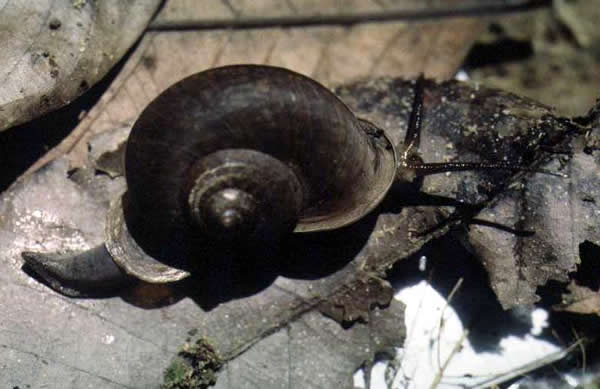
Fig 2-49a The operculum of Cyclophorus is easily seen.
51 Q - How can you tell if the shell had an operculum when it is a dead shell and the operculum is not present?
A - In general, operculate land snails have a round aperture and have solid shells, frequently with spiral ridges.
53 Q - What is a slug?
A - A slug is any terrestrial snail that the shell has been completely lost or has been reduced to a plate buried in the mantle. The slug form has been derived independently in several unrelated snail families. You can think of slugs as being similar to round leaves. All plants with round leaves are not closely related. They evolve to fit an ecologic niche and are not a natural evolutionary related group. They are an example of convergent evolution.
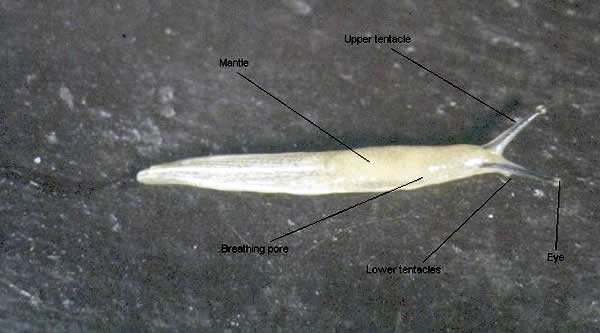
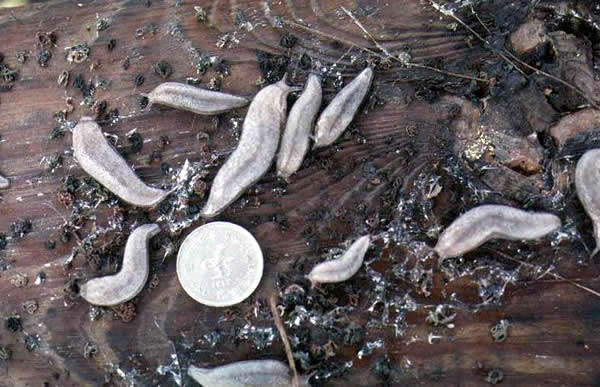
Fig 2-53b Slugs
54 Q – What sex are slugs?
A - Slugs are all hermaphroditic pulmonates which means they are both male and female in one animal and breath with "lungs".
55 Q - What are the advantages and disadvantages in the world of slugdom?
A - A shelled snail has the protection of the shell from predators and desiccation. It can be sealed with an epiphragm and become a safe haven in times of drought. The disadvantages are that it takes energy to build the shell, demands a source of calcium salts, and limits mobility. A slug trades the shell for mobility, energy saving in not building a shell, and no need for calcium salts. It must provide alternate protection from predation and desiccation. This is accomplished by mucus secretions and mobility.
56 Q – What happened to the slug’s shell?
A - The trend in Pulmonate snails is for the shell to become reduced in size relative to the soft parts and/or become completely covered by the soft parts. In many snail groups there are some species in which the shell has become reduced to a remnant.
57 Q – Where are slugs found?
A – Slugs have a very wide distribution in the temporate and tropical regions. Because of their resistance to desiccation and mobility, slugs have been introduced to many regions, especially the families Milacidae and Testicellidae and to a lesser extent Limacidae.
58 Q - What are ideal slug living conditions?
A - A slug "Garden of Eden" would have frequent rains, forest cover to impede evaporation, and coastal mountain areas which would extract the moisture from the clouds. These ideal conditions are present in the regions of present native distribution.
59 Q – Do people like slugs?
A - Years ago when you played the wishing game of being any animal in the world, did you ever want to be a slug? Well, neither did I. It is only in my later years that I've become interested in slugs. Maybe it's because they are one of the few things slower than I am.
61 Q - How good is the snail's sense of touch?
A - In snails the whole outer skin is sensitive to touch. This is easily demonstrated in any species.
63 Q - How well do snails see?
A – Although the snail eye has a cornea, lens, and retina its vision is not very good. Here is an experiment you can do. When a snail senses that something is going to touch its eye tentacles, the tentacles pull back into its head. Wait until a snail's tentacles are stretched out fully. Slowly bring a finger closer and closer to its eyes. At what distance does either tentacle begin to shrink back into the snail's head? Do you think a snail's sight is very good? When we make movements in the vicinity of a creeping snail, the animal stops and begins to retract its tentacles and head. If we had not disturbed or jolted it, this behaviour can only be a reaction to shadowing. This is no doubt an adoptation useful as a defensive reaction to a possible enemy. The light sensitive area of the skin is especially the anterior part of the body at the edge of the shell. The efficiency of vision among snails varies greatly. Some species seem able to do no more than distinguish between light and dark, while other groups have highly specialized eyes. Some pulmonate snails are short sighted and they see better in faint than in bright light. Some can perceive objects better at a distance of six centimeters in dim light than at four or five millimeters in strong light. Some of the operculates, on the other hand, are comparatively longsighted, perceiving objects at distances up to thirty centimeters.
65 Q - Is sight used in movements?
A - The direction of movement can be changed by shining a light on just one tentacle. The snail moves his direction as well as his head and tentacles to get out of a beam of light. Other parts of the body are also sensitive to light.
67 Q - Do snails have a sense of taste?
A - The senses of smell and taste are considered together, since a distinction between them is seldom possible. The main centers of sensitivity are the tentacles, the lips, and especially the anterior edge of the foot. The sense of smell, referred to as “touch at a distance”, is probably the most important sense which the snail posses. It is unquestionably far more valuable to them than sight.
71 Q - Can snails hear?
A – It is generally believed that snails are deaf. During experiments, it is not easy to be sure the animal is not affected, at least in part, by the shock or jar, rather than by the actual sound.
73 Q - Do snails have a homing instinct?
A - Snails are only active during the day when it is cool and/or damp. They are most active at night. A strange phenomenon is that many snails return to the same daytime hiding place after each night's search for food.
75 Q - How do they accomplish this return to the hiding place?
A – Homing is accomplished by the use of mucus. Trail following is the ability to follow the mucus track laid down by itself or another snail. Both olfactory and trail following pheromones (chemical substances secreted externally which convey information to and produce specific responses in other individuals of the same species) are present in the mucus. If one of the olfactory pheromones is destroyed, by water for example, the trail following pheromone is still present.
83 Q - Are we looking at homing from the wrong direction? Is the homing instinct to keep the snail from roaming too far from its hiding place?
A – More research is the answer.
85 Q - Do snails have teeth?
A - The operculates vary from the single tooth per row on the radula to forms with over 800 teeth in each row and a total tooth count of perhaps 75,000. Pulmonate snails have a variable patterns in number of teeth. Specialized food types have multiple changes in cusp structure and tooth number. Carnivores have fewer and larger teeth than related herbivores. Species that specialize in algal cell piercing and those taking fungal juices will have extremely numerous and tiny teeth, up to perhaps a maximum of 250,000.
87 Q - How do snails feed?
A - Snails posses a rasping tongue, the radula, supported by a 'cartilage' and operated by muscles. This movable structure works against a fixed horny jaw in the roof of the mouth. Look at the mouth-parts of a grazing snail through a lens and you can see how it presses its mouth against the glass pane, opens its lips, and lets the radula glide over the algal film. You can also see how it cuts a swathe through the algae in its path.
89 Q - What do snails eat?
A – Snails will eat live and dead plant and animal matter. Many snails browse on the film of lichens and unicellular algae coating tree trunks, fallen branches, and stones. Other snails are carnivores which will feed on other species or their own. Fungi are a favorite food for Helicophanta. No snail species has been found dependent on a particular species of plant, and this applies to the provision not only of food, but of shelter as well.
91 Q - Does their food vary with the species?
A – Each genus seems to have its own food preference.
93 Q – How are snail table manners?
A – One scientist observed, “In all its feeding Achatina, though easily disturbed, impressed me as being leisurely, even desultory, in contrast to the brisk activity of a caterpillar engaged upon the same task."
95 Q - Do carnivorous snails have special features in common?
A – The common carnivore features are: comparatively few, but very long and slender radular teeth (for grasping and tearing); a somewhat enlarged and concentrated nervous system (to interpret data); development of lobes either on the tentacles or near the mouth that act as chemical sensors (to locate prey); often a slender and quite long elongated body that can be stretched far in front of the shell edge (to enter shell of prey); and an expanded foot gland (for swift pursuit).
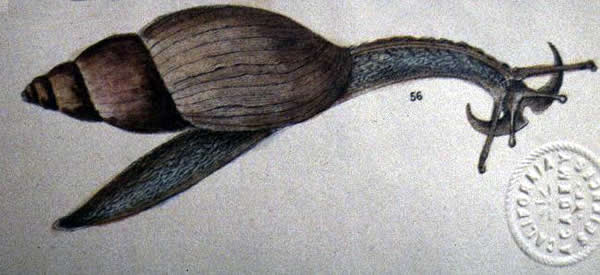
Fig 2-095a Carnivores have slender bodies and special sensing organs on the
head.
97 Q - How do predator snails locate their prey?
A – They don’t lurk behind a tree on the edge of the trail and pounce. They follow the slime trail of their prey.
98 Q – For how long is the slime trail readable?
A – If kept dry for 24 hours, it is still readable. If soaked in water 30 minutes, it is not readable.
99 Q - How do they know which way the snail was going?
A – The direction of trail following is determined not by trail cues but by differential illumination. If a snail finds its prey or mates by this means, the lack of trail controlled directionality in following should be a considerable handicap. It must be remembered that the snails were influenced by illumination in their original trail direction so this need not be such a serious problem as it would first appear.
101 Q - How does the predator kill its prey?
A - Euglandina rosa and Edentulina ovideus enter the aperture of the prey. An anesthetic may be used. The New Zealand Paryphanta eats worms live and whole, kind of like spaghetti.
103 Q - How do land mollusks breathe?
A - In the air-breathing pulmonates the interior of the mantle cavity is converted into a lung and a pumping mechanism for renewal of air is established. The restriction of the respiratory aperture is necessary. The mantle forms the roof of the cavity and is covered with ridges in which pulmonary veins converging towards the auricle. The floor of the cavity is arched and has a layer of muscles, which contract rhythmically. When the muscles contract, the arch flattens and air is drawn in and at the limit of contraction a valve slides across the pneumostome. When the muscles relax, the cavity decreases in size and exchange of gases with the blood in the roof vessels is facilitated by the increase of pressure of the contained air. Then the pneumostome opens and air is expelled; the subsequent contraction of the floor muscles brings in a fresh supply. This 'breathing' is not so regular or so frequent as in a vertebrate; moreover, it may cease altogether in the winter when the snail hibernates.
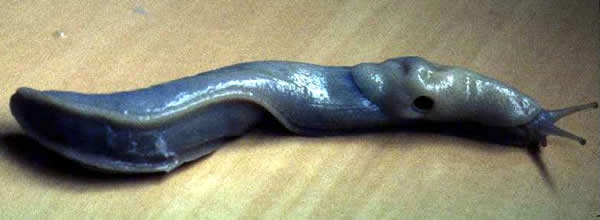
Fig 2-104a
105 Q – How long can land snails “hold their breath”?
A - The process of respiration is most easily observed in land snails. The condition of the pneumostome - wide, scarcely open or closed – shows the breathing stage. Observe the condition of the pneumostome in various slugs and snails in motion and in repose. How often is the pneumostome opened and closed? Is its behavior in resting animals different from that in creeping ones? Respiration in gilled (operculate) snails proceeds by the uptake of oxygen dissolved in the water into the blood with the simultaneous release of carbon dioxide.
107 Q - What is the air consumption of snails?
A – Some snails kept in containers three times their volume were alive after several days.
109 Q – Do snails need oxygen?
A – The need for oxygen can be demonstrated by exhaling carbon dioxide into the snail aperture. This will entice the snail to come out.
111 Q - How can snails endure heat and cold?
A - Snails are capable of enduring severe extremes both of cold and heat. The operculate snails, in spite of the protection which their operculum may be supposed to afford, are exceedingly sensitive to cold. Maybe this is why they are a product of tropical or semi-tropical regions. Pulmonate snails have been found in the Himalayas at 17,000 ft and at 15,000 feet in the Andes. They are present in the Algerian desert where there is no vegetation and mid-day temperatures of 110o F. Freshwater snails can live in 122o F. water.
113 Q - How do snails which live in cold regions avoid freezing?
A - They build up an antifreeze in their blood.
115 Q - How do snails handle their need for water?
A – Most snails are probably more water sensitive than is usually believed. The humidity of the air affects the surface of their skin to a considerable extent. Every one has noticed how the snails 'come out' on a damp evening, especially after rain. The mucus of slugs and snails besides its use in facilitating locomotion, is a contrivance for checking evaporation by surrounding the exposed parts of the bodies with a viscid medium. The mucus has an affinity for water. Consequently when you try to rid your fingers of mucus do not get them wet. This will only make the mucus more fluid and sticky. To remove the mucus rub your hands together and the mucus will dry and peel off like glue. The pulmonate snail can carry an extra supply of water in the pallial cavity. This extra water supply permits them to be more active than operculates. Since the pulmonate can be active at lower humidity because of its extra water supply, they will return to activity before the operculates.
117 Q – What is the epiphragm?
A – The epiphragm is a seal of dried mucus across the aperture of a snail shell to prevent loss of moisture during aestivation.
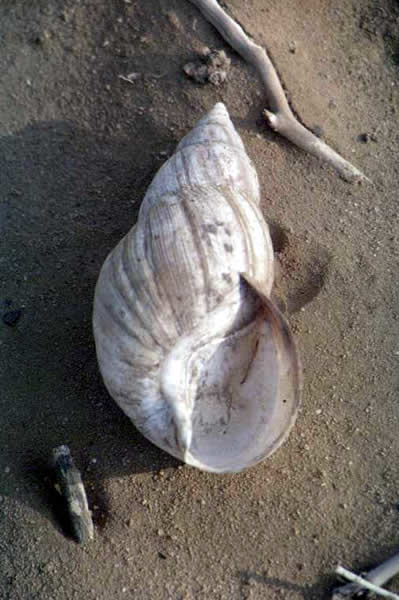
Fig 2-117a Achatina fulica with epiphragm.
119 Q - How does the epiphragm work?
A - The epiphragm is normally continuous except for a thin grooved slit over the pneumostome which allows reduced respiration to take place. Any disturbance which causes the aestivating snail to withdraw farther into its shell will invariably ruptures the epiphragm. The snail then has choices: it may repair it, replace it with a new one, add an additional one, or go into a period of activity. The epiphragm performs, to a certain extent, the function of the operculum. It must be remembered that it differs radically from an operculum in being only a temporary secretion, while the operculum is actually a living part of the animal.
121 Q – What is the difference between hibernation and aestivation?
A – Hibernatation is to spend the winter in a dormant state and estivation is to pass the summer in a dormant state.
123 Q - How do snails hibernate or estivate?
A - In hibernation or aestivation operculate and pulmonate snails react similarly. The heart of the pulmonate may slow down from 36 beats per minute to only three or four. In the operculates it may drop from 53 to only two to three times per minute. As an indication of how much body processes are slowed down, a hibernating pulmonate at 30oF will use as little as 1/50th the amount of oxygen used by an active snail at 59oF.
125 Q - Is estivation only done to combat weather?
A – There is direct correlation between estivation and reduced moisture in the environment. There is a tendency in an individual for phases of estivation to alternate with phases of activity. Even under approximately constant external conditions some of the animals would be in either phase. The reason for estivation is a low water content, and that the latter may be brought about either by dryness of the environment or else by the natural hydration cycle of the animals.
127 Q - Is preparation needed for cold or estivation?
A - Snails will adjust to remarkably low temperatures if they are arrived at slowly enough. Snails put suddenly in a cold chamber will die in a short time. Yet if several days are taken to gradually reach the temperature in the cold chamber, these snails will undergo physiological changes, including the alteration of the water content of the cells, and withstand successfully the lower temperatures for prolonged periods of time.
129 Q Do snails have sex?
A - A necessity for land life independent of a return to water for reproducing is internal fertilization coupled with retention of the eggs until they are ready to give birth to live young (viviparity) or laying eggs with a hard covering (oviparity). Among the oviparous species are the Helicophanta which lay eggs 33 mm (1.3”) or the size of small chicken eggs. The snail laying the largest eggs is the South American Strophocheilus popelairians with eggs to 51 mm. There are a few viviparous land snails. "The preliminary to successful egg laying is successful mating.” The vertebrates depend on visual or sound signals to recognize potential mating partners and then use stereotyped behavior patterns to entice a mate. Many insects depend on chemical signals which are followed by 'courtship flights.' Snails have a problem! They do not see very well and have no ears, so they depend on a sense of touch coupled with behavior patterns. If several closely related species live in the same area, species differences in structures and behavior are needed in order to separate like and non-like partners. This brings about elaborate supplementary genital structures. Some species use a dart apparatus which secretes a calcarious or chitoneous darts that are jabbed into the body of the mating partner as an identification signal. Others depend on differences in the soft genital structures. Some even may use a distinctive 'sperm packet' for species recognition.
131 Q - How can you tell if a snail is sexually mature?
A – The snails which develop aperture teeth and/or reflected lip are sexually mature when these features are developed. For those without these physical features only size can be used. When the shell is almost full size, it is sexually mature.
133 Q - What and where are the snail's sex organs?
A - The reproductive opening is located in the head! The reproductive organs themselves are in the visceral hump.
134 Q – How do snails find a mate? Is it at a snail’s pace?
A – The method used is slime trail following. The same method as prey detection.
135 Q - Do snails have courtship?
A – You bet! Reproduction in some hermaphroditic snails begins by engaging in a preliminary love-play. A pair of snails raise the creeping sole of their feet off the ground and bring them together. At the same time they rock their bodies to and fro and actively caress one another with their greatly extended tentacles. After a short time the love-play passes into a love-duel; each snail projects its calcareous love-dart into the sole of its partner’s foot (only if the snail has a dark sack). Thereupon the two animals become interlocked, often for a long time, until they once more raise themselves and the actual mating occurs. During mating each everts its penis and ejects the fertilizing sperm into the vagina of the partner. The two snails then separate, and each stores the sperm of the other until its own eggs have ripened.
137 Q - How does copulation take place?
A – It has many manifestations. The Great Grey Slug of Europe (Limax maximus) actually mates in mid-air while both partners are suspended by a stout thread of mucus from a branch of a tree! Most snails lie side by side joined by their sexual organs. In the inch long Caribbean Cerion the mating process which takes place on the ground is not a reciprocal one; that is, an animal is not actively male and female at the same time, but one functions as male and the other as female. The copulation of Helicophanta ibaraoensis is rarely recorded. Here is an observation made by George Williams in Ranomafana National Park.
At 8:15 on 1/22/99, a sunny day with heavy dew, a snail was seen on the trail near V150. It was still active when I passed again at 9:05. At 8:23 two Helicophanta ibaraoensis were found copulating near V100. He returned at 8:38, 9:40, 11:10, 11:45 , and 13:30 with no obvious change in the snails' positions. At 15:30 the snails were separate and one was moving. At 15:42 the other was also moving. At 16:24 they had each moved about a foot from the original spot, and had retracted within their shells and gone inactive. The next morning (1/23/99) at 7:45 only one snail remains, no sign of eggs where the other was. The remaining snail was inactive but slightly out of its shell. At 14:00 the other snail has gone too. He checked the area for snails and eggs but all he found was a small mucilaginous mess where the snails had copulated.
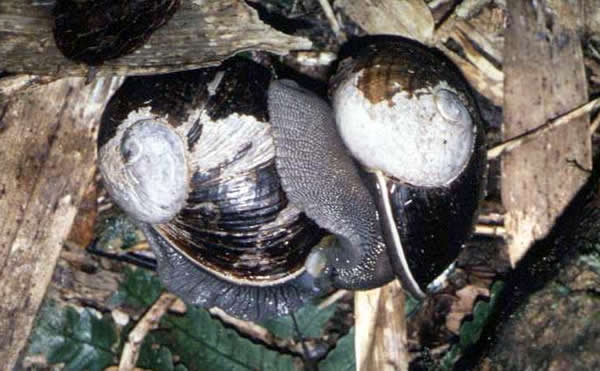
Fig 2-137a Helicophanta ibaraoensis mating.
139 Q - Does self-fertilization occur?
A - Cross-fertilization is the rule but self-fertilization does occur.
141 Q - Does self fertilization have genetic problems?
A - Most freshwater snails can self-fertilize for two or three generations without difficulty in genetic factors. Pulmonate snails will use cross-fertilized sperm in reproduction in preference to sperm from the same individual. This ability of self-fertilization is a very significant feature, because it enables the snail to establish a new colony by means of a single individual. This is only possible if the individual can hold out for a fairly long time at its new location. In every possible situation it will use cross-fertilization to maintain genetic diversity.
143 Q - How, where, and how many eggs are deposited?
A - After mating, slugs and snails dig small holes in the soil or in cracks in rotting wood or under logs or stones and lay clutches of eggs. The number of eggs in a clutch varies greatly, often 20-50 in large species, but sometimes 100 or more. The eggs are usually round. In some species, they are rather soft and transparent; in others they have a hard, opaque, calcareous shell. More than one clutch may be laid in a season.
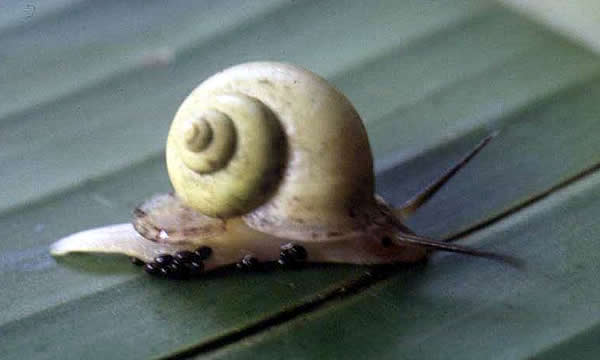
Fig 2-143 Eggs are usually small.
The eggs are usually small but some species have very large eggs.
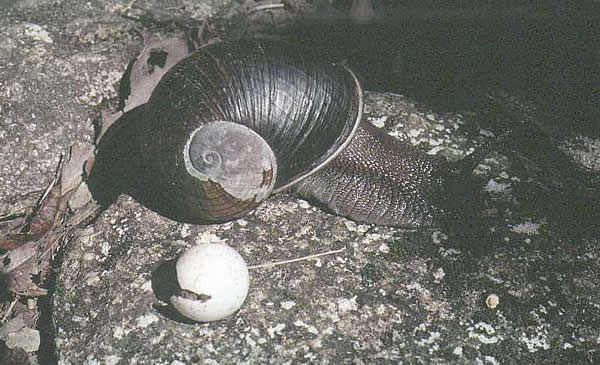
Fig 143b Egg and 90 mm Helicophanta ibaroensis shell for scale.

Fig 143c The egg is almost the size of a chicken egg.
The time between copulation and oviposition varies with the species. With Achatina fulica it is 1 to 2 days. Other species may be days to months. Most snails bury their eggs to protect them from predators and also ensures that sufficient moisture is available for their subsequent development. Therefore, frequent hoeing is a good method of controlling slugs and snails in the garden. Achatina fulica’s small eggs (6 mm long) are glistening and hard when they are deposited just below the surface in loose soil. They are pale yellow when laid and remain so until 24-48 hours before hatching. At that time the shell becomes soft and dull in appearance.
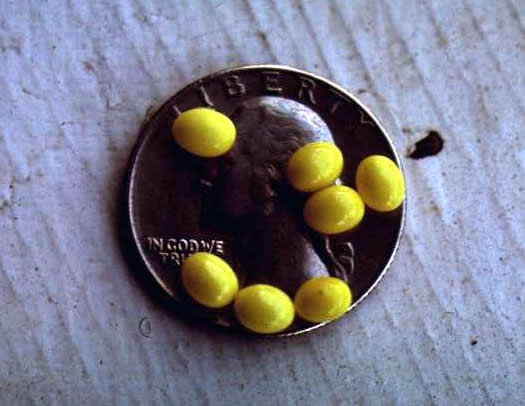
Fig 143d Achatina fulica and eggs.
145 Q - How do eggs develop?
A – When the young are hatched, they are miniature adults. There is no metamorphosis or molting. Young snails grow by the mantle adding material to the leading edge of the shell which in turn adds morewhorls. The Achatina fulica snails in a clutch emerge to the surface en masse, usually within a few hours. In some cases, one or two individuals force a path through the sand to the surface and the others following the same route. After hatching, they eat their shells, and sometimes the shell of unhatched siblings. Much of the growth is in the first month with a little less in the next two months.
147 Q - How many offsprings can a snail have during its lifetime?
A – We have some information about the egg laying capacity of Achatina fulica.
ASSUME: Achatina fulica has a life span of about 6 years. Reproduction starts at end of year 1 and continues for 5 years followed by death. Yearly eggs per reproductive year per individual 100, 300, 400, 200, 100. Since Achatina are hermaphroditic, both parents can produce off springs!
| Parents | |||||
| End |
Generation
|
||||
Year |
1
|
2
|
3
|
4
|
5
|
| 0 |
0
|
||||
| 1 |
200
|
0
|
|||
| 2 |
600
|
40,000
|
|||
| 3 |
800
|
360,000
|
1.6 x 109
|
||
| 4 |
400
|
640,000
|
129.6 x 109
|
2.6 x 1018
|
|
| 5 |
200
|
160,000
|
409.6 x 109
|
16,800 x 1018
|
6.8 x 1036
|
During the life of the parents (6 years), the following offspring by generation could be produced assuming all eggs are fertile and all young live to adulthood.
| Parents |
2,000
|
| 2nd gen |
1,200,000
|
| 3rd gen |
540,800,000,000
|
| 4th gen |
16,800,000,000,000,000,000,000
|
| 5th gen |
6,800,000,000,000,000,000,000,000,000,000,000,000
|
Only two surviving offsprings are required during the parent's lifetime to insure a no growth or stable population. The remainder die from parasites, predators, desiccation, and old age. Let’s try to visualize the magnitude of these numbers. If we further assume that a shell is one square inch in cross-section and all the shells are standing vertically, they would cover the entire surface area of 7,700,000,000,000,000,000 worlds or if the shell is 6" tall, cover one world to a depth of 720,000,000,000,000 miles.
149 Q - With this reproductive capacity why aren't we inundated by snails? The constraints must be formidable. Where is Achatina's "Achilles’ heal"?
A - Are the eggs infertile? No, the egg fertility is 26% in early stage of development and 82.5% in later stage.
What about the juveniles?
About 75% of clutch might attain an age of 180 days, fewer than 5% reach 300 days. Youth seems to be the vulnerable time.
How do they die? Most predators are not species restricted but eat whatever is available. Young snails are more desirable because of their thin shell. Therefore, predation is greater on young than on mature snails. Predation, however, does not seem to be frequent enough to be very effective in controlling the population. Diseases do cause "fatal epidemic" conditions. One such disease is leukodermia (a lack of skin pigmentation) which causes tuberculations on the foot. The snails become sluggish, suspend feeding, and ultimately die. This causes great reductions in number. Parasites are more species specific and can cause widespread death. Desiccation is a possible major contributing factor. The young with their thin shells may be very vulnerable. I have frequently found estivating shells attached to a surface without a body inside. This may be a population control. There is often a sharp increase in the death rate following a period of intense reproductive activity.
151 Q - What is the main factor in snail activity?
A – The rate of evaporation determines, inversely, the rate of snail activity. The rate of evaporation is the result of the combined action of wind, temperature, and dryness of the air.
153 Q - How do snails move about?
A - Land snails move utilizing a variety of methods. These are:
1) glide on the sole of the foot by means of ripple like bands that proceed from the tail to head. This is the method used by Ampelita and Helicophanta. The shell is rested on the tail as the snail crawls in a continuous smooth glide.
2) the "waddlers" such as the Jamaican Colobostylus walks only on the edges of the foot which has a convex cross-section. The wave of contraction moves first from one side of the foot from back to front, then a similar wave on the other side. It leaves two tiny trails of mucus.
3) there is also a modified conch lurch or hitch. Truncatella extends the proboscis, the foot and shell are pulled up, and the proboscis extended again. Clavator is a hitcher. Thus a snail moves, not on the ground, but on its own mucus, which it deposits mechanically, and which serves the purpose of lubricating the ground on which it travels.
155 Q - How speedy are snails?
A - There is the "snail's pace". A movement of a few inches per minute is common for large snails or slugs. Small relatives of the operculate genus Colobostylus can move 7 times their shell length each minute. A few larger land snails "lope" or "gallop" by creating extraordinarily large locomotor waves in the foot. The speed of the European garden snail, Helix aspersa, is dependent on the surface on which it moves. The average speeds for movement on a paper towel is 6 1/3 cm/min, on a glass plate 8 1/3 cm/min, and on a formica surface 17 1/3 cm/min.
Fig 2-155a
157 Q - What is the snail speed record?
A - The Costa Rican mountain snail Velifera has a shell diameter of 1/8 inch. It raises the front half of its foot off the ground and glides only on the posterior half. It traveled 18"/minute when exposed to sunlight! This need for speed is because the shell is reduced and the animal cannot withdraw inside. It is very vulnerable to drying out and being eaten.
159 Q - Do land snails descend from trees by free falling rather than climbing down?
A – Many tree snails have irregular pits in the shell of the body whorl. These pits are attributed to an injury caused by the snail falling from vegetation. Look at Helicophanta shells for the pit marks. I have seen a different example of shell breakage in Malaysia. There were many shell fragments of the tree snail Amphidromus scattered around an exposed rock. From the evidence it appears the snail fell from a tree and hitting the rock was broken into many pieces. Damaged and malformed shells are frequently found in tree snails. This may be explained by an observation that 'snails which have ascended trees, walls, etc. do not climb back the way they have come, but let themselves drop down. Although a well developed shell can withstand an enormous pressure, the sharp knock when reaching the ground often causes it to crack open'. The snail may be capable of repairing its damaged shell, but it is likely that malformations can originate.
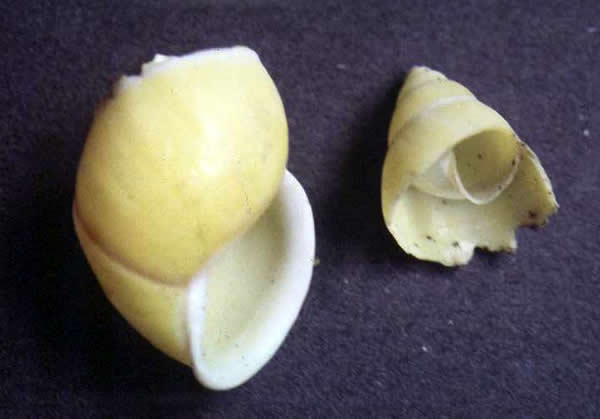
Fig 2-159a Fallen Amphidromus.
The essentially terrestrial African Achatina albopicta does climb trees and walls. It also climbs down with the spire pointing downward. It is believed that it often falls to the ground from the stress of sheer weight. This is most often when it is awakening from its resting stage and would attempt to seize hold of the substrate. Maybe it was a case of not being fully awake!
165 Q - How strong are snails?
A - The muscular strength of snails is surprisingly great. An experiment on a Helix aspersa weighing 1/4 oz showed it could drag vertically a weight of 2 1/2 oz., or ten time its own weight. Another snail weighing 1/3 oz. was able to drag in a horizontal direction along a smooth table twelve reels of cotton, a pair of scissors, a screwdriver, a key, and a knife, weighing in all no less than 17 oz. or more than fifty times its own weight. This was much the same as asking a man of 168 pounds to pull a load of over 4 1/4 tons.
167 Q - How tenacious are snails to life?
A - Land snails have been known to exhibit, under unusual conditions, remarkable tenacity of life. The most famous story took place at the British Museum when two snail were received on the 25th March 1846. The two specimens of Helix desertorum had been collected in Egypt some time previously. They were fixed upon tablets and placed in the collection of the museum. There they remained glued to the tablet until about 15th March 1850 when examining some shells in the same case a recently formed epiphragm was noticed over the mouth of one of the snails. On removing the snails from the tablet and placing them in tepid water, one of them came out of its shell. The next day it ate a cabbage leaf. A month or two afterwards it began repairing the lip of its shell which was broken when it was first affixed to the tablet. There is an 1877 record of Buliminus pallidior and H. veatchii from Cerros Island living without food from 1859 to March 1865.
169 Q - Why are there so many dead shells of adult and juveniles?
A - Mortality is heaviest in the very early stages of life. The eggs may dry out, be found and eaten by predators, or parasitized by flies. Because the small young are also vulnerable to climate and enemies, it is quite usual for 5 per cent or less of eggs laid to reach adulthood. In small species most adults die soon after breeding making the life-span is little more than a year. Some may survive a second season. In large species only half or less of the adults die each year. Some individuals may live 8 to 10 years, and possibly longer.
171 Q - What age do snails achieve?
A – This is a very general question. Snail ages vary greatly. Five years is about the average age of the common garden snail.
172 Q – What is a “death assemblage”?
A – The empty shells, death assemblage, found on the ground are a two-dimensional representation of a four dimensional event. We normally perceive objects in three dimensions – length, width, and height. The forth dimension of time can be added. In a death assemblage the four dimensions are reduced to two – length and width. Height is lost because the tree dwellers and land dwellers are mixed. Time is lost because we don’t know the dying sequence. The shells are together in death, but they may have been living in different habitats and at different times in life. The arboreal, terrestrial, and soil dwellers are all mixed together regardless of their original habitat and time sequence. The death assemblage doesn’t tell us anything about the shells that have decomposed and are no longer in the assemblage.
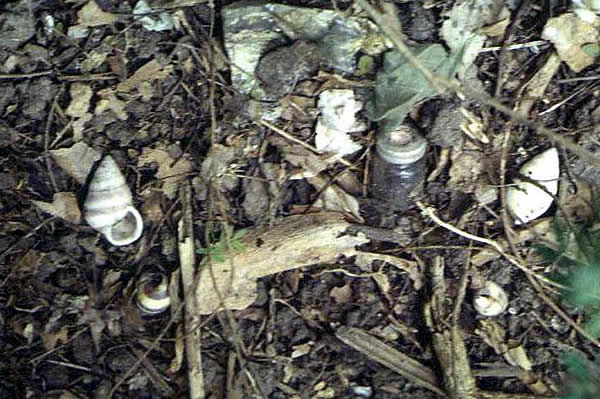
Fig 2-172a Death assemblage.
PREDATORS, PARASITES, & PROTECTION
173 Q - Who could possibly be the enemy of lovable snails?
A - Many deaths are caused by predators and parasites. There are shell breakers which attack land snails, the chief culprits being birds, mammals, and some reptiles and beetles.
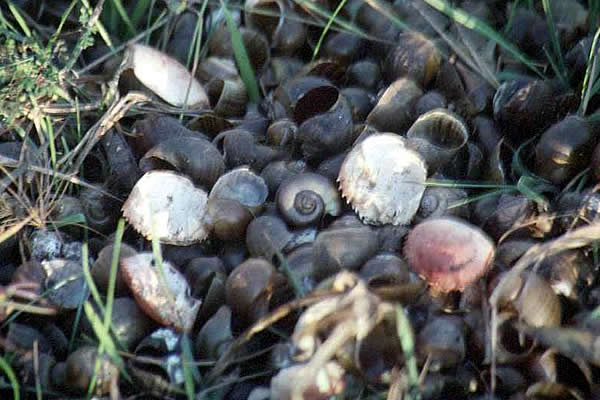
Fig 2-173a Midden of snailkite.
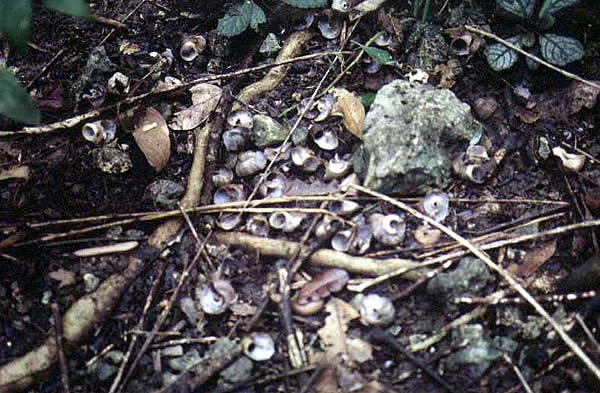
Fig 2-173b Cyclophorus midden of ?.
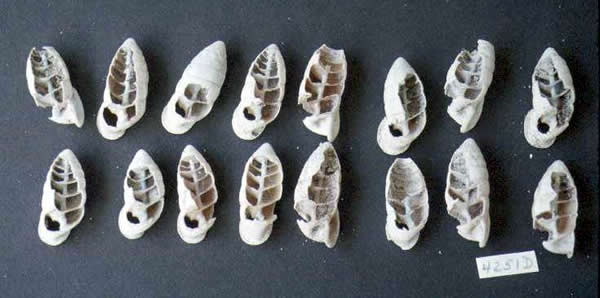
Fig 2-173c Cerion predation by rats(?).
175 Q - Do we have any snail gourmets?
A – Every thing likes to eat snails. Their predators include mammals, birds, reptiles, frogs, toads, crabs, mematodes, beetles, glow-worm, ants, bees, flies, and molluscs. The extinct Madagascar Snail-eating Coua fed principally on snails. It is not known which species were preferred.
177 Q - Who are the snail eating mollusks?
A - Carnivorous snails generally have elongated bodies to permit entry into the aperture of their prey. They also have special sensing organs on the head. The families involved are: SPIRAXIDAE - Streptostle manumbendes and Euglandina rosea and STREPTAXIDAE - Edentulina ovideus. They insert themselves into aperture of their prey and may use anesthetic.
179 Q - What are the prey species of snails?
A - There are few prey the snail can "out run". Almost all are caught when encountered or when at rest. The most important prey are other snails, often of the same species.
181 Q - What mechanical means of protection do snails have?
A - The shell is the snails passive mode of defense. Inside the aperture of many snails are many teeth, sometimes so numerous and so large that it is puzzling to understand how the animal can ever come out of its shell.
183 Q - What chemical means does the snail use?
A - It is possible the froth of sticky slime emitted by many land snails may be an irritant to an intruder. Garlic odor of the worldwide introduced Oxychilus alliarius has been shown to repel hedgehogs from eating it.
185 Q - Are there venomous land snails?
A - Unlike marine snails with the venomous cone shells and the poisonous mussels, land snails are relatively harmless. However, the literature does refer to some “poisonous” land snails.
187 Q - What is the ecological impact of snails and slugs?
A – Except for seeing them in their gardens most people are aware that mollusks exist. Yet an acre of damp hardwood forest can have 4,500,000 to 11,500,000 snails quietly scraping away at decaying leaves and bits of fungi. An acre of open meadow may have 566,000 snails and 87,000 slugs. Land snails play a major role in recycling organic matter back into simple chemicals that can then be reused by plants. If mollusks were removed from the food chain which circulates matter and stored energy through the living and nonliving worlds, serious dislocation would result. Despite their almost inconspicuous ways, snails play an important and large role in the economy of nature. The United States national “Harpers Magazine” stated that the maximum number of months humanity could survive without invertebrates is 6!
189 Q - Can land snails be used in animal research?
A – One may wonder why the Giant African Snail which is so easy to dissect and to keep in captivity has not been employed more for anatomical and physiological studies. Some of the marine slugs posses chemicals of medical value. Why not land snails? We have a whole world of possibilities to explore but we must do it before they become extinct.